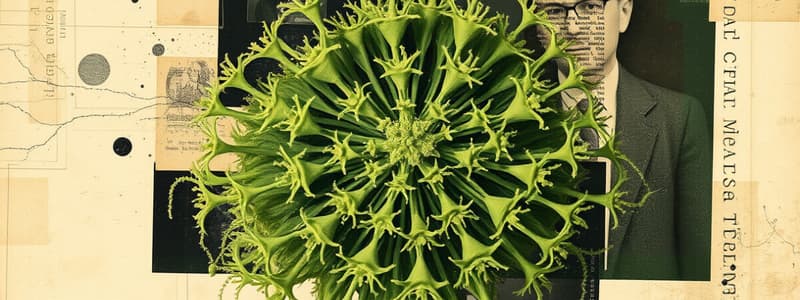Podcast
Questions and Answers
What is the Charophyceae?
What is the Charophyceae?
- A species of flowering plants
- An ancestral group to Kingdom Plantae (correct)
- A class of red algae
- A monophyletic group of green algae
What is a significant difference between Chara, Coleochaete, and Plantae?
What is a significant difference between Chara, Coleochaete, and Plantae?
Chara and Coleochaete have a zygotic life cycle, while all Plantae have a sporic life cycle.
Which of the following features do Coleochaetes share with plants?
Which of the following features do Coleochaetes share with plants?
- Oogamous reproduction (correct)
- Sporic life cycle
- Unicellular zygote
- Two flagella
What explains the relationship between zygotic lifecycle and bryophyte reproduction?
What explains the relationship between zygotic lifecycle and bryophyte reproduction?
Why would bryophytes have a dominant gametophyte generation?
Why would bryophytes have a dominant gametophyte generation?
The green algae are a monophyletic group.
The green algae are a monophyletic group.
What defines Kingdom Plantae?
What defines Kingdom Plantae?
Which of the following is unique to plants?
Which of the following is unique to plants?
Flashcards are hidden until you start studying
Study Notes
Charophyceae
- Paraphyletic group of green algae that includes ancestral lineage to Kingdom Plantae.
- Key genera, Chara and Coleochaete, exhibit cellular and chemical similarities to Plantae.
- Charophyceae feature zygotic life cycles; in contrast, Plantae possess sporic life cycles.
- Understanding the evolutionary transition from zygotic to sporic life cycles is vital for grasping Plantae origins.
- Earliest true plants exhibit a dominant haploid phase (gametophyte), despite the advantages of the diploid phase (sporophyte).
- Charophyceae with true plants (Plantae) form a monophyletic group known as Streptophyta, embedded among other chlorophytes.
Features of Coleochaete and Charales
- Morphological traits in Chara resemble those of higher plants.
- Molecular data indicate Coleochaete's closer genetic relationship to plants.
- Cellular processes include:
- Mitosis: Characterized by nuclear envelope breakdown and formation of a phragmoplast.
- Pigments: Contains chlorophyll A and B and phytochrome for light sensing.
- Reproductive strategy is oogamous, featuring asymmetric sperm attachment.
- Zygotes are retained and supported by haploid individuals through specialized transfer tissue.
- Sporopollenin provides resilience against environmental challenges like fungi and acids.
Zygotic Lifecycle Similarities to Bryophytes
- Bryophytes possess dominant, free-living gametophytes, akin to Coleochaete's structure.
- Coleochaete features oogonium and antheridium, with the zygote depending on the oogonium's nutrient support.
- In bryophytes, the sporophyte relies on the gametophyte for nourishment, paralleling nutrient transfer in Coleochaete.
Evolution of Bryophytes from Coleochaete-like Ancestors
- Nutritional dependence of zygote on oogonium supports the evolutionary shift.
- In Bryophytes, multicellular archegonium evolves, allowing mitosis within the gametophyte.
- First bryophytes exhibit prolonged haploid gametophyte stages, transitioning to later vascular plants with dominant diploid sporophytes.
- The quick meiosis of the diploid sporophyte reinforces the dominance of the haploid gametophyte generation.
Green Algae Paraphyly
- Green algae, termed Chlorophytes, form a paraphyletic group as their common ancestor also leads to all land plants.
Kingdom Plantae
- Also known as "embryophytes," highlighting the retention and nourishment of the embryo by the gametophyte.
- This unique trait differentiates plants from other life forms; majority of characteristics are synonymous: Plantae, embryophyte, true plant, land plants.
- Major subdivisions include bryophytes, seedless vascular plants, gymnosperms, and angiosperms, providing a framework for plant classification.
Common Features of Kingdom Plantae
- Embryophytes demonstrate a relationship through traits such as:
- Oogamy for reproductive strategy.
- Heteromorphic alternation of generations between gametophyte and sporophyte stages.
- Presence of chlorophyll A and B for photosynthesis.
- Non-flagellated spores enhance survival rate and dispersal.
- Sporopollenin confers resistance against environmental stressors.
- The retention and nourishment of the embryo are unique to plants, setting them apart from other organisms.
Studying That Suits You
Use AI to generate personalized quizzes and flashcards to suit your learning preferences.




